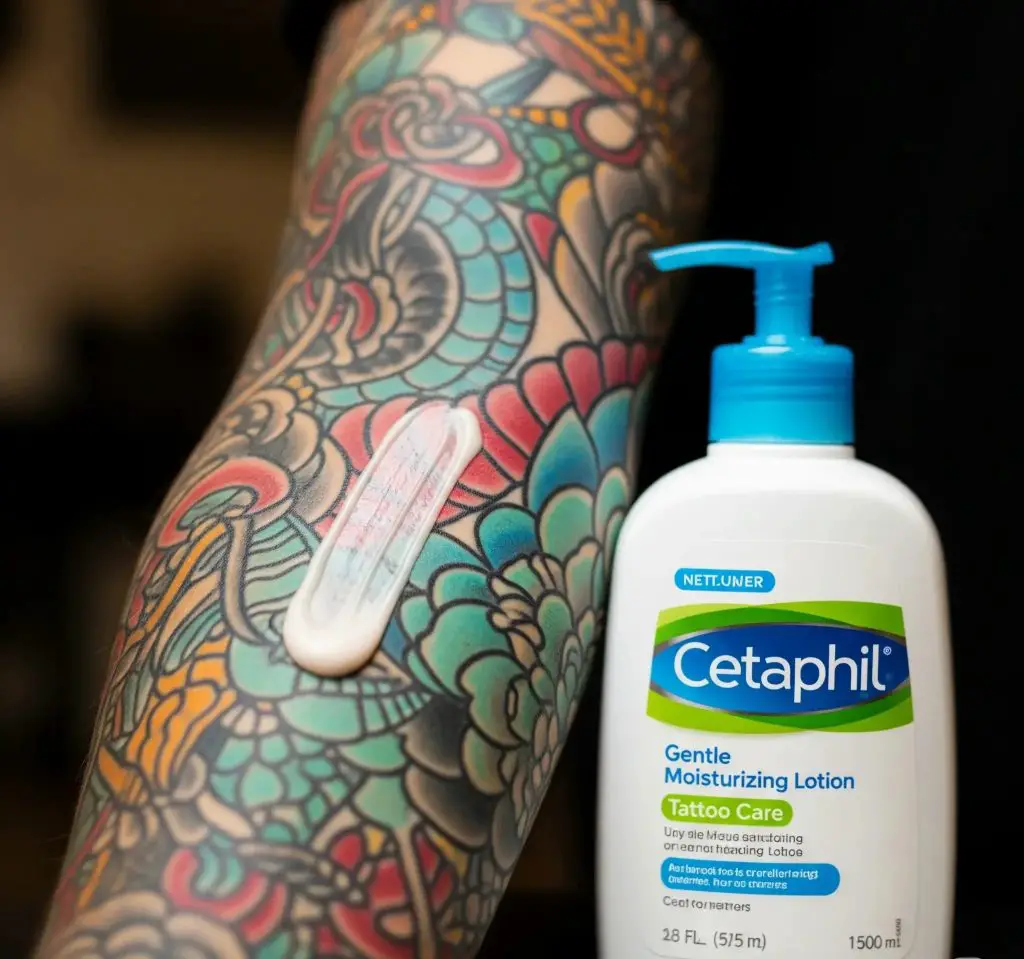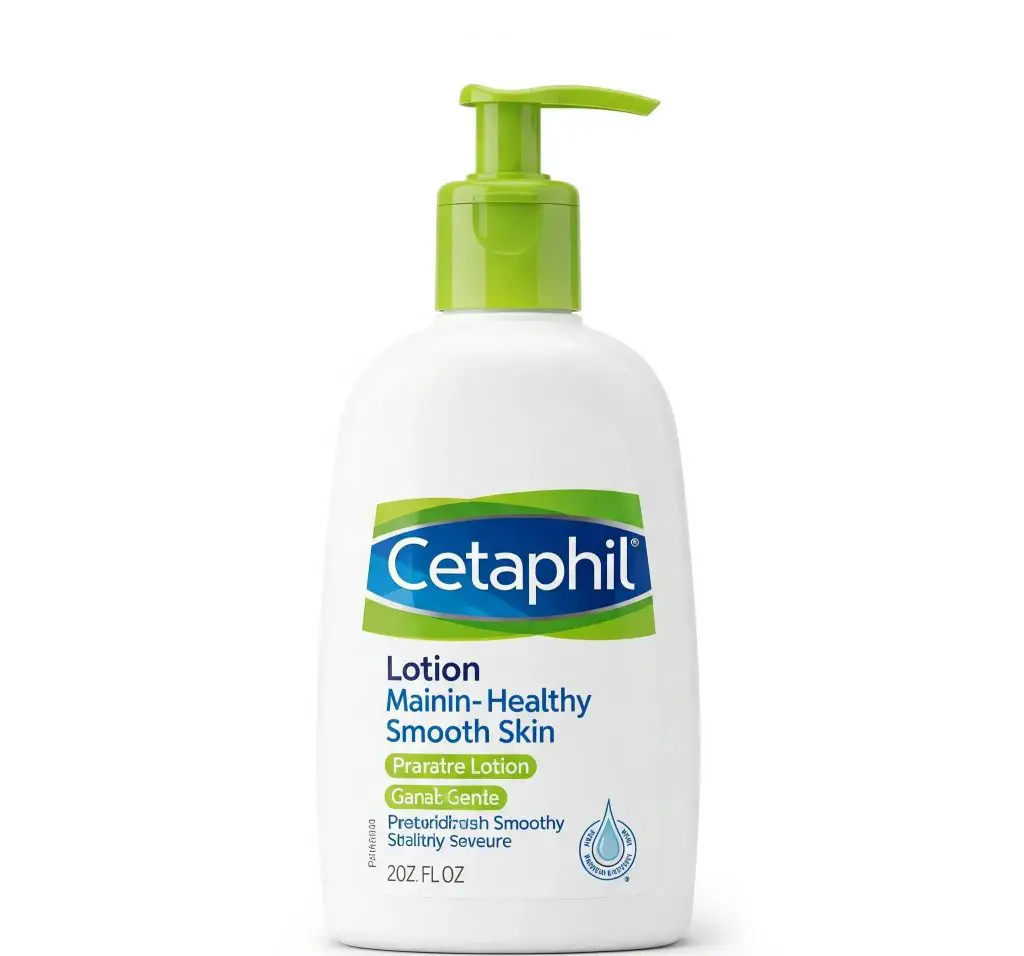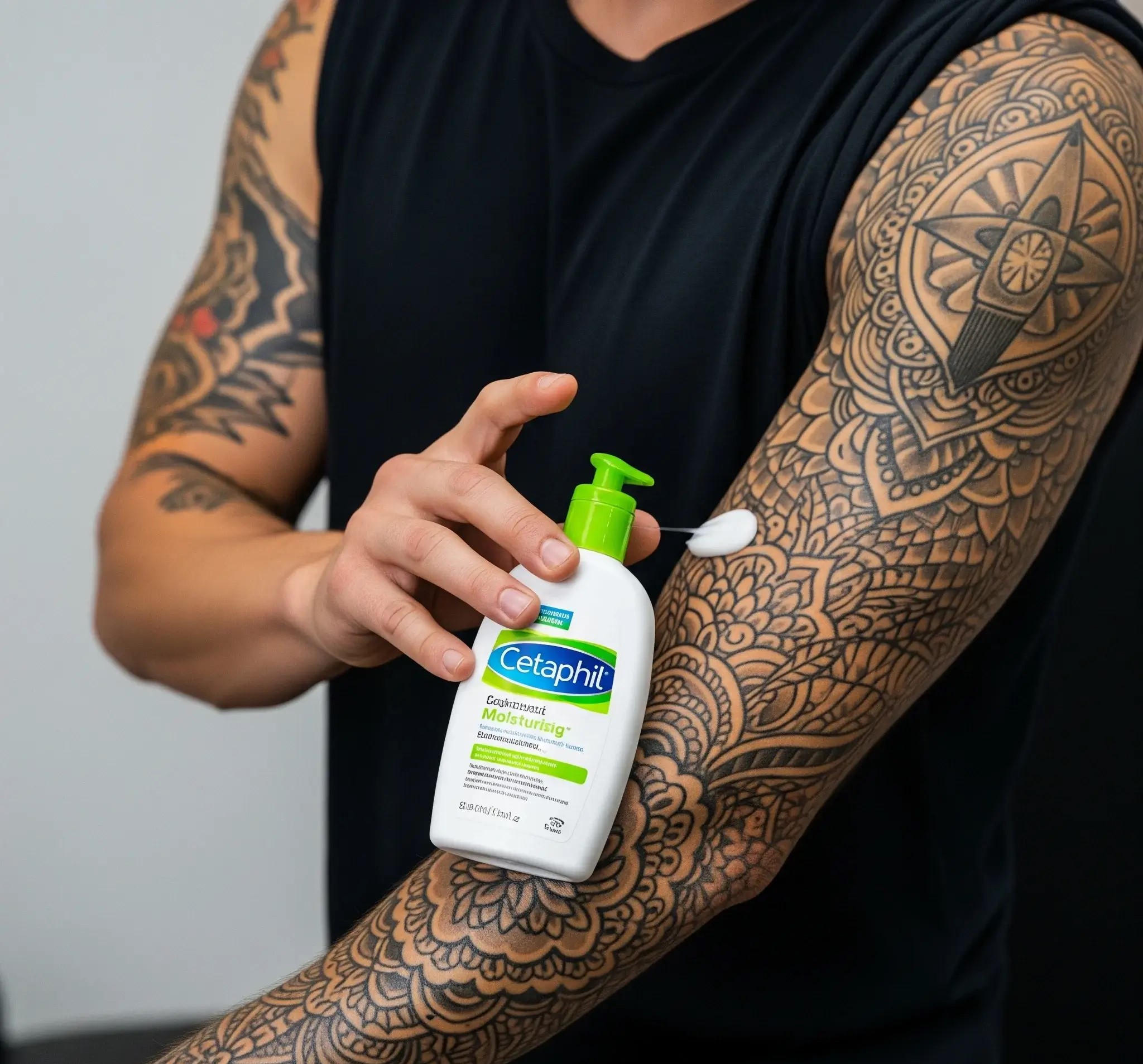Got a new tattoo and wondering how to take care of it without messing it up? You’re not alone. One of the most common questions people ask is, “Can I use Cetaphil lotion on my tattoo?”
When your skin is sore, dry, and peeling after getting inked, choosing the wrong lotion can slow healing or even fade the design. That’s why it’s important to use something gentle and effective.
Cetaphil is a well-known skincare brand trusted for its mild, fragrance-free products. But is it safe for tattoos too?
In this article, you’ll learn everything you need to know about using Cetaphil on a fresh tattoo—including when to start, how much to apply, and which version is best.
Can I Use Cetaphil Lotion On My Tattoo?
Yes, you can use Cetaphil lotion on your tattoo, especially during the healing process.
Cetaphil is known for its gentle, fragrance-free formula that works well on sensitive and irritated skin—exactly what your tattooed skin becomes after getting fresh ink.
But like any skincare product, it’s important to understand how, when, and which type of Cetaphil to use to avoid causing irritation or slowing down healing.
Is Cetaphil Safe For New Tattoos?
Absolutely. Cetaphil is considered one of the safest over-the-counter lotions for newly tattooed skin.
It’s free from alcohol, dyes, and strong fragrances—things that can dry out or inflame your healing tattoo.
Dermatologists often recommend Cetaphil for sensitive skin and minor wounds, which makes it a reliable choice for aftercare.

Benefits Of Using Cetaphil On Healing Tattoos
- Non-irritating formula: It’s gentle enough for daily use on fresh ink.
- Fragrance-free: No added scents that can trigger allergic reactions or redness.
- Hydrating: Keeps the skin moisturized without clogging pores.
- Lightweight texture: Absorbs quickly without leaving a greasy residue.
How To Apply Cetaphil Lotion On A Tattoo?
Follow these simple steps to safely use Cetaphil on your tattoo:
- Wash your hands with antibacterial soap.
- Gently clean the tattoo using mild, fragrance-free soap and lukewarm water.
- Pat the tattoo dry with a clean paper towel (don’t rub).
- Apply a small amount of Cetaphil lotion with clean fingers—just enough to lightly moisturize.
- Use twice daily or whenever your tattoo feels dry or tight.
When Should You Start Using Cetaphil On A Tattoo?
Start applying Cetaphil lotion 2–3 days after getting your tattoo, once the initial oozing and bleeding stop.
During the first couple of days, your tattoo artist may recommend using a healing ointment like Aquaphor or A&D.
Once your tattoo enters the peeling phase, switch to a gentle lotion like Cetaphil to keep your skin hydrated and reduce itching.
Cetaphil Lotion Ingredients: Are They Tattoo-Friendly?
Yes. The basic ingredients in Cetaphil moisturizing lotion include:
- Glycerin: Hydrates and attracts moisture to the skin.
- Panthenol (Pro-Vitamin B5): Soothes and heals irritated skin.
- Cetyl & Stearyl Alcohol: Fatty alcohols that soften skin (not drying like regular alcohol).
- No parabens or fragrances in some formulations (always check the label!).
These ingredients are safe for tattoo aftercare and promote gentle healing.
Cetaphil vs. Tattoo-Specific Aftercare Products
While tattoo-specific lotions are made just for inked skin, Cetaphil is a trusted drugstore alternative that works just as well for many people. Here’s a quick comparison:
| Feature | Cetaphil | Tattoo Lotions |
|---|---|---|
| Affordable | ✅ | ❌ (Usually more expensive) |
| Easily Available | ✅ | ❌ (Some need to be ordered online) |
| Fragrance-Free | ✅ | ✅ |
| Tattoo-Specific Formula | ❌ | ✅ |
If you’re on a budget or prefer drugstore options, Cetaphil is a solid choice.
Can Cetaphil Cause Tattoo Fading or Irritation?
Not usually. As long as you use fragrance-free Cetaphil lotion and apply a thin layer, it will not cause fading.
However, over-applying lotion or using a version that contains added ingredients (like SPF or scent) could lead to:
- Blocked pores
- Excess moisture trapped in scabs
- Mild irritation or delayed healing
Stick to the basic moisturizing lotion and avoid any version with added sunblock or exfoliating agents.
Best Cetaphil Products For Tattoo Aftercare
These two products are the most recommended:
- Cetaphil Moisturizing Lotion (Fragrance-Free)
- Cetaphil Moisturizing Cream (for very dry or flaky tattoos)
Avoid using Cetaphil cleansers or scrubs on your tattoo unless specifically approved by your tattoo artist.
What Dermatologists Say About Cetaphil For Tattoos?
Many dermatologists support using Cetaphil as part of tattoo aftercare. It’s especially recommended for people with:
- Eczema or sensitive skin
- Allergies to fragrances or dyes
- Dry or flaking skin during tattoo healing
Since healing tattoos are technically open wounds, using a gentle, non-comedogenic lotion like Cetaphil can help your skin recover without complications.
Pros And Cons Of Using Cetaphil On Fresh Ink
✅ Pros:
- Gentle and non-irritating
- Easily accessible and affordable
- No alcohol, dyes, or fragrances
- Great for dry, flaky skin
❌ Cons:
- Not specially designed for tattoos
- Can feel too light for very dry skin (in that case, use the cream version)
- Some people may prefer a thicker balm early on

How Often Should You Apply Cetaphil On A Tattoo?
Apply 2 to 3 times a day or whenever your tattoo starts feeling dry, tight, or itchy.
The key is to avoid over-moisturizing, which can suffocate the skin or prolong healing. Always apply a thin, even layer.
Cetaphil Moisturizing Lotion vs. Cetaphil Cream: Which Is Better For Tattoos?
| Feature | Lotion | Cream |
|---|---|---|
| Texture | Lightweight | Thick and rich |
| Best For | Normal skin | Very dry or peeling skin |
| Absorption | Fast | Slower |
| Daily Use | ✅ | ✅ (use less often) |
For most tattoos, start with the lotion and switch to the cream only if your skin is very dry.
Is Fragrance-Free Cetaphil Better For Tattoos?
Yes, fragrance-free versions are ideal. Fragrances can irritate freshly tattooed skin and increase the risk of an allergic reaction.
Always check the label to make sure you’re using the original or sensitive skin formula.
Final Thoughts
Read More Articles:
- Can You Ice A Tattoo?
- Is Hemp Lotion Good For Tattoos?
- [Essential] Guide To Tanning Bed Use With New Tattoos!
- Can I Use Olive Oil On My Tattoo? Full Aftercare Guide
- Why Is My Tattoo Turning White? Causes & How to Fix It
- How Bad Does An Ankle Tattoo Hurt? Real Pain Guide
- Oops! [Scratched] Your Tattoo In Sleep? Quick Fixes Here!
- Jergens For Tattoos: [Smart] Aftercare Or Risky Business?
- [Innovative] Methods To Apply Tattoo Stencils Without Deodorant
- The Healing Tattoo: [Why] Ink Loss Is Part of the Process!
- New Tattoo? [Learn] When Tanning Is Safe Again!
- [Week-Old] Tattoos: [Can You] Use Fake Tan Without Risk?
- Considering A Tattoo? [Weigh] Accutane’s Impact First!
